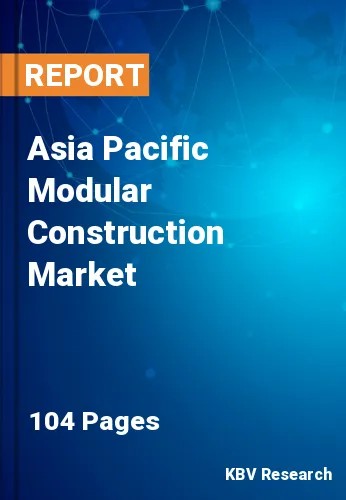The Asia Pacific Modular Construction Market would witness market growth of 8.3% CAGR during the forecast period (2023-2030).
The modular construction approach ensures high quality and consistency in the final product. Modules are fabricated in factory-controlled environments where stringent quality control measures can be implemented. This consistency in construction standards results in buildings that meet or exceed regulatory requirements and industry standards. Modular construction offers unparalleled flexibility in design and application. Modular units can be customized to meet diverse architectural and functional requirements, from residential housing to commercial and industrial structures. The adaptability of modular construction allows for easy reconfiguration, expansion, and repurposing, providing a dynamic solution that can evolve with changing needs over time.
Modular construction has gained popularity in the residential sector for its efficiency and cost-effectiveness. From single-family homes to multi-unit housing developments, modular construction allows for the rapid assembly of residential structures without compromising quality. Developers seeking to address housing shortages or deliver projects within tight timelines often use modular construction to meet these challenges. The commercial sector has embraced modular construction to deliver office spaces, retail establishments, and other commercial structures quickly and precisely. The modular approach accommodates the need for flexible and customizable spaces, catering to the evolving requirements of businesses in a dynamic market environment.
Rapid urbanization in many Asia-Pacific countries has increased energy consumption and environmental degradation. As a response, there's a focus on incorporating green building principles in urban development to mitigate environmental impacts and create more sustainable cities. Supportive government schemes like the Pradhan Mantri Awas Yojana (PMAY) encourage the use of innovative construction technologies, including modular methods, to achieve its ambitious housing goals. Thus, rising awareness and various innovative building initiatives in the Asia Pacific are expected to boost the growth in the regional market.
The China region dominated the Asia Pacific Modular Construction Market by Country in 2022 and would continue to be a dominant market till 2030; thereby, achieving a market value of $9,986.3 million by 2030. The Japan region is registering a CAGR of 7.6% during (2023 - 2030). Additionally, The India region would showcase a CAGR of 8.9% during (2023 - 2030).
Based on Product, the market is segmented into Permanent, and Relocatable. Based on Material, the market is segmented into Steel, Wood, Concrete, and Others. Based on Application, the market is segmented into Residential, Commercial, Industrial, Healthcare, and Educational. Based on countries, the market is segmented into China, Japan, India, South Korea, Singapore, Australia, and Rest of Asia Pacific.
Free Valuable Insights: The Global Modular Construction Market is Predict to reach $159.3 Billion by 2030, at a CAGR of 7.4%
The market research report covers the analysis of key stake holders of the market. Key companies profiled in the report include Sekisui House, Ltd., LAING O'ROURKE, Red Sea International Company, Skanska Group AB, Premier Modular Limited, KLEUSBERG GmbH & Co. KG, Wernick Group, Lendlease Corporation Limited, Hickory Group and Guerdon, LLC.
By Product
By Material
By Application
By Country
Our team of dedicated experts can provide you with attractive expansion opportunities for your business.

